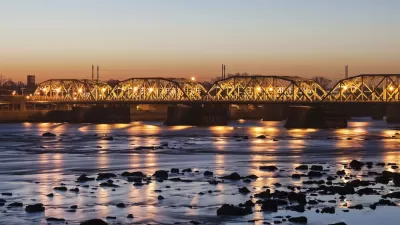In 20 years, dam removal has gone from a "fringe notion" to "wide acceptance." National Geographic explains how and why this sea change occurred.
Michelle Nijhuis reports on the quickly growing trend of dam removal in the United States by first citing the example of White Clay Creek, a tributary of the Delaware River in northern Delaware.
"The White Clay Creek dam was the first ever removed in the state of Delaware, but it was far from the only one removed in the United States last year. On Tuesday, the conservation group American Rivers announced that 72 dams were torn down or blown up in 2014, restoring some 730 miles of waterways from California to Pennsylvania."
According to Nijhuis, supporters of dam removal mostly align behind the cause of fish like salmon, American shad, striped bass, and river herring. Dam removal advocates have scored several high-profile victories, such as the removal of the 210-foot-high Glines Canyon Dam on the Elwha River in Washington state in 2014. But, as Nijhuis explains, "most of the 865 dams removed in the United States during the past 20 years are small structures originally built for flood control, irrigation, or very local hydropower."
The article also includes discussion of how dam advocates have shifter their attention to watershed restoration, which requires removal of several dams at once, as well as international dam removal projects in Europe and Japan.
FULL STORY: Movement to Take Down Thousands of Dams Goes Mainstream

Planetizen Federal Action Tracker
A weekly monitor of how Trump’s orders and actions are impacting planners and planning in America.

Maui's Vacation Rental Debate Turns Ugly
Verbal attacks, misinformation campaigns and fistfights plague a high-stakes debate to convert thousands of vacation rentals into long-term housing.

San Francisco Suspends Traffic Calming Amidst Record Deaths
Citing “a challenging fiscal landscape,” the city will cease the program on the heels of 42 traffic deaths, including 24 pedestrians.

Defunct Pittsburgh Power Plant to Become Residential Tower
A decommissioned steam heat plant will be redeveloped into almost 100 affordable housing units.

Trump Prompts Restructuring of Transportation Research Board in “Unprecedented Overreach”
The TRB has eliminated more than half of its committees including those focused on climate, equity, and cities.

Amtrak Rolls Out New Orleans to Alabama “Mardi Gras” Train
The new service will operate morning and evening departures between Mobile and New Orleans.
Urban Design for Planners 1: Software Tools
This six-course series explores essential urban design concepts using open source software and equips planners with the tools they need to participate fully in the urban design process.
Planning for Universal Design
Learn the tools for implementing Universal Design in planning regulations.
Heyer Gruel & Associates PA
JM Goldson LLC
Custer County Colorado
City of Camden Redevelopment Agency
City of Astoria
Transportation Research & Education Center (TREC) at Portland State University
Jefferson Parish Government
Camden Redevelopment Agency
City of Claremont





























